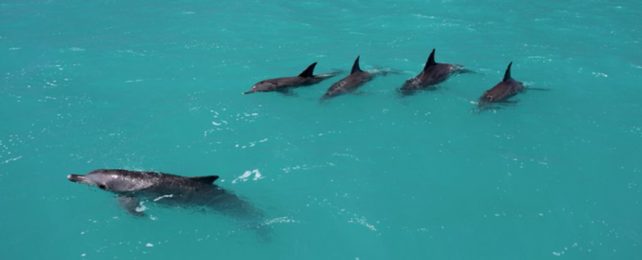A new study has discovered a 'frat-boy culture' in dolphin society to rival our own.
Beyond humans, researchers say dolphins are the only species known to form such complex, cooperative 'bromances'.
Other animals, like chimpanzees, show fierce male rivalry in their bid to mate with females. Their interactions don't end in cooperation but in violence.
Male dolphins, however, are surprisingly cooperative. Not only do males form multiple alliances, those different groups often work together to woo the lucky females.
When researchers tracked 121 adult male Indo-Pacific bottlenose dolphins (Tursiops aduncus) in Western Australia's Shark Bay, they found males with stronger alliances consorted with female dolphins more and had greater reproductive success.
An individual male would usually team up with about two or three other males when pursuing a female. These are kinda like the human equivalents of wingmen.
What's more, almost all the adult male dolphins in the study also belonged to a second-tier social alliance of between 4 and 14 other dolphins. And strangely enough, these larger alliances would not always compete with other second-tier teams for female attention.
Instead, sometimes they actually joined forces – creating a third tier of alliances.
When this happened, the males were much more successful at mating with females. Their cooperation, in other words, reduced competition. The relationship between groups (rather than alliance size) had the biggest impact because it allowed the males more time to court the females.
"We show that the duration over which these teams of male dolphins consort females is dependent upon being well-connected with third-order allies, that is, social ties between alliances leads to long-term benefits for these males," says ethologist Simon Allen from the University of Bristol.
Intergroup cooperation was thought to be a unique feature of humankind, so why do dolphins seem to have evolved something similar?
Unlike humans, mating dolphins don't form pair bonds, and males don't help raise their young, so it's quite surprising that they can work together so well. While their promiscuous social structures are more similar to chimpanzees than us modern humans, dolphins nevertheless form human-like strategic multilevel male alliances.
So what is it about dolphins and humans that sets us apart?
We don't yet know, but researchers suspect it has something to do with the social brain hypothesis. This hypothesis states that complex relationships might have been a driving evolutionary force for the large brains and intelligence of both humans and dolphins.
"The discovery of strategic, multilevel male alliances in dolphins is a surprising case of convergence that broadens our understanding of human social and cognitive evolution," the authors of the study write.
The study was published in PNAS.
